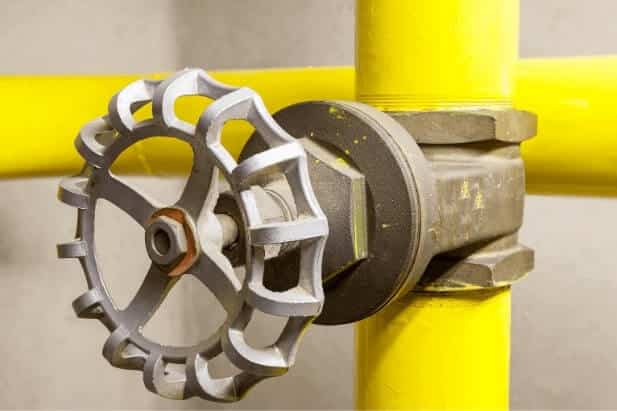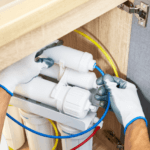
Most Common Problems with Shut Off Valves

A shut off valve plays an important role in a home’s plumbing system or any other building. Even if you never have to use a shut off valve, it’s essential to know where to find them and to keep them in good working condition.
Why is that so important? A shut off valve can mean the difference between relatively minor damage and thousands of dollars worth of damage when a plumbing emergency occurs. Some plumbing emergencies that can cause catastrophic damage and huge messes include a burst pipe, a toilet that won’t stop running and is overflowing, a badly leaking water heater, and a failed sump pump.
When these types of emergencies occur, flooding and raw sewage are the top concerns, and the first step before calling a plumber is to cut off the water supply. Shut off valves are located at strategic points in the system so that you can quickly shut off the water near the source of the problem.
Toilets, sinks, and water heaters typically have individual shut off valves that control the water flow. However, every building should have a main shut off valve to cut off the entire water supply when an emergency arises. Usually, the main shut off valve is in a basement, on an exterior wall, or in an underground box outside the home.
Usually, a shut off valve has either a round handle that can be turned in either direction, fully closing and fully opening the water flow, or a lever to pull to open or close the system. These are also called gate valves.
Although shut off valves are there to help solve problems, and they can develop problems of their own. Age, corrosion, wear and tear, and sediment buildup can all cause problems with shut off valves, so it’s important to know what those problems are, how to check for them, and to know what to do when they occur.
The Gate Valve Is Free Spinning
A gate valve has a stem, and if the stem turns and turns for you while not exerting any control over the water flow either way, there’s a good chance that the stem is broken off at the gate or the threads on the stem have been stripped to the point that they no longer operate the way they’re supposed to.
Valves are often made from copper and brass, which are soft metals, so they are prone to breaks like that described here. A leak can develop, but even worse, you can’t cut off or reopen the water supply if needed. If this happens to one of the secondary shut off valves, you at least still have the main one, but if it happens to the main one, you should immediately get it repaired or replaced.
The Gate Valve Is Stuck
A gate valve can also become stuck (seized) in either the open or shut position, which means it cannot perform its function correctly and that it might develop a leak. This can happen from lack of use, so you should regularly open and close a valve to make sure it doesn’t become stuck.
Make sure to turn off the water, isolate the area to protect from further leaks if leaking has occurred, look for possible causes (wear, corrosion, excessive cold, damaged water line), and place something beneath the valve to catch excess water before you remove or replace it. If you can’t fix the problem on your own (a wrench and some WD-40 might be all you need), then call a professional plumber who will have the tools and the knowledge to get the job done.
Valves may also only partially open or close rather than being stuck in the on or off setting. The remedy for this is the same as above.
Saddle Valves
Older homes and plumbing systems may have saddle valves with handles that look like the letter T. Saddle valves are notoriously vulnerable to leaks, so if you have them in your home or in another building, consider replacing them with regular shut off valves as soon as possible. This might save you from dealing with messy and expensive water damage sooner or later.
The Shut Off Valve Dripping or Leaking Water
When a valve is in the off position for a long period of time and then is turned back on, it probably will drip water. Try tightening the valve’s packing nut and then turn the valve off and back on a few times. If the dripping continues, contact a professional plumber for help.
Burst Pipe
It’s common for a family going on a winter vacation to cut off the water supply and turn down the heat while they’re gone in order to save money and avoid frozen and burst pipes. Many don’t know that when you turn off the water, there can still be water between the shut off valve and the spigot, and that water can freeze, causing the pipe to burst. You won’t notice until you turn the water supply back on, so check for it when you do.
Help With Shut Off Valves
Plumbing repairs can be the stuff of nightmares, and when they’re needed, you need professional services you can count on for quality, efficiency, and integrity. In the greater Fort Lauderdale area, you’ll get all three from 4 Star Plumbing Services.
We’re fully licensed and insured, and our plumbers are professionally trained and certified, so you can count on us to get the job done right the first time. As part of our commitment to integrity and value, we also offer fair, upfront pricing with no hidden fees and a 100% satisfaction guarantee behind our work. Whatever the issue is, we can fix it, so if you need a plumbing repair, installation, or maintenance, contact us today!
Sean Hasle is a third-generation plumber, serving the South Florida area with his family. He is a licensed plumbing, underground utility, and fire contractor.

